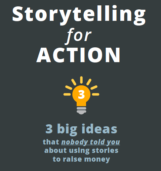I’m going to tell you something that is counter to what most nonprofits think.
But it’s tested and proven. Hundreds of times for hundreds of organizations, large and small. Here it is:
If you want to raise the most money, tell a story that is not finished and ask the donor to finish it with a gift today.
Thats a bit conceptual so here’s an example. Most fundraising appeals tell stories that go something like this:
“Lisa was homeless and in dire straits. But thanks to our 4-step program, Lisa is doing great today. Will you please give a gift to help us continue this good work?”
Notice how Lisa’s story is finished? She’s already been helped. The only role for the donor to play is to ‘help the organization continue the work.’
We talk about this in detail in our free ebook on storytelling that we’re launching soon, but that type of story works OK at best. Your best donors might give to it. But most of your donors won’t.
If you want to raise more money — and catch the attention of more people — tell an unfinished story of need like this:
“Lisa is homeless and in dire straits. Will you please give a gift today to help her stay in our shelter?”
Do you see the difference? Lisa still needs help! The donor feels that, and sees exactly how a gift today will help Lisa.
Lisa’s story is unfinished, so your donor has a role to play. And your donor sees how her gift will do something simple and powerful — providing a night of shelter — which donors love.
Here’s another way to think about it:
- Most nonprofits ask donors to help them do more of what the nonprofit has already done.
- What works better in fundraising is to ask donors to help people who have not yet been helped or are currently being helped.
The is one of the fundamental principals we teach in our training on how to Ask powerfully. Use it in your next appeal and watch your results soar!
Steven Screen is Co-Founder of The Better Fundraising Company and lead author of its blog. With over 30 years' fundraising experience, he gets energized by helping organizations understand how they can raise more money. He’s a second-generation fundraiser, a past winner of the Direct Mail Package of the Year, and data-driven.









I know this is the stronger way to invite donors to make a difference, but where I struggle is this: is there an ethical issue with telling a finished story in an unfinished way? Or is the idea that you don’t tell the finished story, you only tell unfinished stories?
Hi Liz, great question. In general, it’s only unethical if you ask the donor to provide assistance to the person in the story when that person does not need the assistance any longer. What we generally do is tell the story of the person in a way that illustrates the need that they faced/help that they needed. Then ask the donor to provide the help that someone in that situation needs today. Then you’ve used the story to illustrate the problem/situation faced by the people you help, but asked the donor to help whoever needs that help now. Additionally, you absolutely want to tell ‘finished’ stories too. But instead of telling them in appeals, tell them in newsletters and other ‘report backs’ to donors. My general rule of thumb is that when I’m asking for help we tall an unfinished story to illustrate the need a donor’s gift can meet, and when reporting back we tell a finished story to illustrate the impact a donor’s gift has had.